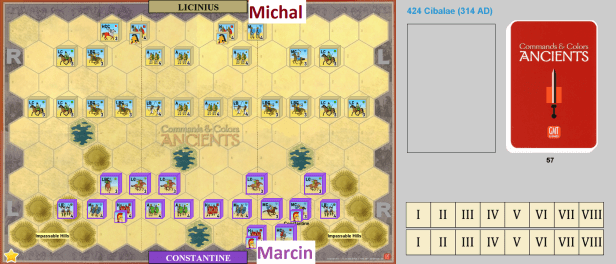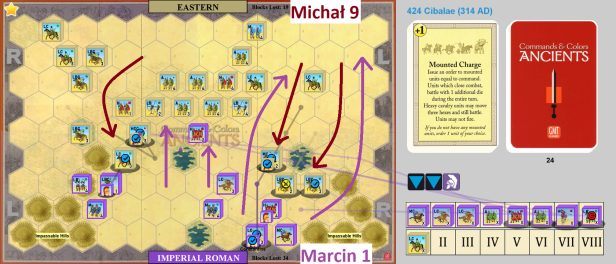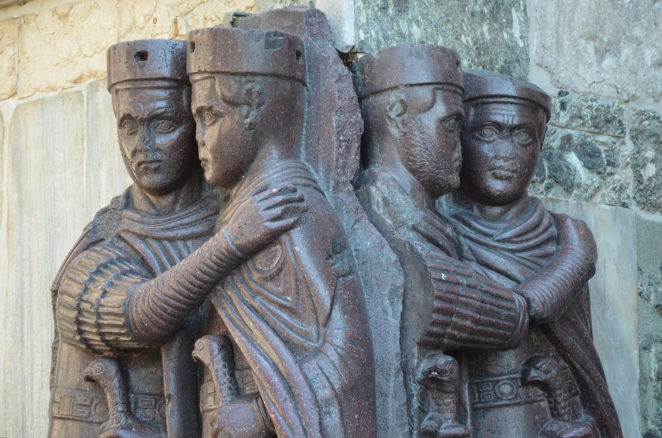I am continuing my forced lockdown Vassal plays. Today short session report from Commands Colors Ancients mini-campaign – Civil Wars of Tetrarchy. As mentioned multiply times on my blog, I like playing C&C games in consecutive, chronological series where the conflict unfolds through the series of battles. Today’s report features one of the greatest Roman Emperors – probably second only to Augustus – Constantine the Great and his successful struggle for power. Enjoy!
Milvian Bridge (312 AD)
Historical background
Before reporting the game, some historical background. While emperor Diocletian’s “Tetrarchy” system of shared power maintained calm for 20 years, eventually rivalries took over again. In 306 Maxentius proclaimed himself emperor, setting off another confused civil war. In 312, Constantine decided to resolve the dispute with Maxentius (his brother-in-law!) for control of the Western Roman Empire. With an army drawn from his western provinces of Britain, Gaul, and the Rhine, Constantine invaded Italy. He defeated Maxentius at Taurinorum, and expected Maxentius to hold out in Rome but instead he made a stand less than ten miles from Rome, in front of the Milvian Bridge crossing the Tiber River.
Maxentius’ deployment was faulty, as his huge army was much too close to the Tiber River to allow room to maneuver. Although out-numbered, Constantine’s army attacked first and succeeded in pushing Maxentius’ forces back toward the river, with Constantine personally leading his Gallic cavalry forward. Even Maxentius could not cross at the bridge and drowned. Constantine marched into Rome after the victory and was declared the sole Western Roman Augustus. Constantine later claimed a dream told him he would succeed “under this sign” and this victory aided the rise of Christianity as Rome’s state religion.
Report

- The game started from the range attacks exchange where Marcin’s forces – less then optimally placed by Maxentius – were hit not being able to ignore flags
- The true action took place on wings; first Marcin’s force attacked on my left, killing two units
- And I responded with counter-attack on my right, hitting hard with cavalry and completely obliterating that section.
- The rule – reflecting the faulty disposition of Maxentius forces – which allows to kill whole unit with one flag is cruel but accurate. Constantine cavalry used it to maximum and the battle score was quickly set-up:

It is really hard scenario for whoever commands Maxentius – and so it was also this time. The key is not the number but disposition of forces which prevents maneuverability. Being killed while pinned to board edge / river also does not help.
After this, we immediately jumped to second scenario in this mini-campaign.
Exp4-Cibalae (314 AD)
Historical background
In the years after Milvian Bridge, Constantine gradually consolidated his military superiority. Licinius emerged as Constantine’s chief rival. After defeating Daia, Licinius gained control over the entire eastern half of the Roman Empire. Relations between the Constantine and Licinius gradually deteriorated. Upon learning that Licinius was conspiring against him, Constantine marched east and the two armies met about 200 miles within the territory of Licinius, near Cibalae in Pannonia. Licinius’s army took up a position on the edge of a plain, intending to attack Constantine as he emerged from a narrow passage through hilly country and swamps. Constantine, however, covered his deployment with light cavalry and gained maneuvering space. The battle lasted from dawn to dusk. It ended when Licinius’s left wing gave way and his army withdrew under the cover of darkness. Licinius was forced to flee to Sirmium.
After losing a second battle to Constantine, Licinius conceded his Balkan provinces to Constantine in exchange for a cessation of hostilities. In a second civil war with Licinius (323-324), Constantine finally re-united the Roman Empire under the rule of one man for the first time in over three decades.
Report

- That was strange game. Marcin immediately attacked on his right flank, pushing me almost till the board edge.
- I managed to evade most of the attacks, having good cards to regroup and then to strike with Darken the Sky and my own Medium cavalry. It worked!
- The situation completely reversed, as it was now Marcin’s cavalry and infantry pinned on the other side of the board, being mercilessly picked by my mounted archers.
- The last chance to change the situation was Constantine charge in the center which despite initial successes, was stopped.
- And then, with last Mounted Charge played, I put a last nail to the victory!

One of the few Cibialae Licinius victories but as shown above, completely possible. The extent to which light mounted archers and Cataphracts can obliterate Roman legions can be shocking but not unprecedented (eg. Carrhae).
Summary
Playing those scenarios is always fun. They are huge for normal CCA format, you need to show tactical proneness and planning in order to prevail and with so many banners to get, you will not win by chance or lucky roll. Obliterating the opponent is the only way 🙂
PS. That battles would be perfect for and EPIC battle. I think I will try it some day 🙂

